Offset
Randomini Tool
Reform Panel
Stylism Tool
Reprofile Panel
AG Offset
AG Offset Tool
AG Offset Panel
Illustrator Location:
Advanced Toolbar > Randomini Tool
When one or more art objects are selected and the Randomini tool is in use, its widget will appear, initially centered over the bounds of the selected art (it may later be repositioned; see below). By using the cursor to click or drag parts of the widget, the artwork can be edited. Except for Hue, all changes are previewed using outlines and are not actually applied to the art until the Apply button is clicked or the Enter key is pressed. Therefore, if you change your mind and decide not to randomize the art, simply switch to another tool and the art will remain as it was. All parameters are retained between uses of the tool. When not over a widget control, the cursor for the Randomini tool has the shape of a die showing various random faces. When nothing is selected, the Randomini tool can be dragged to marquee-select artwork.
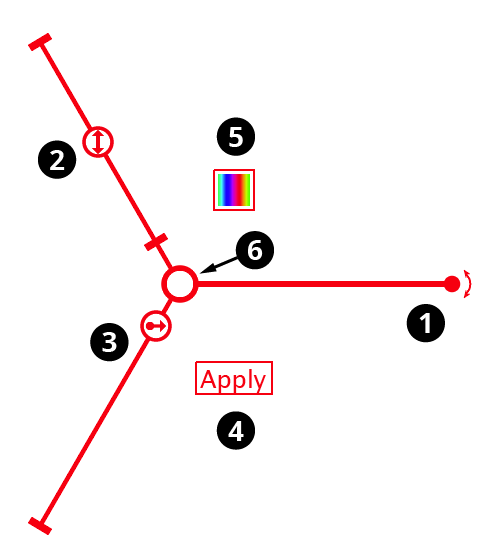
Randomino annotation widget
1. Rotation arm and control
Dragging the rotation control changes the angle up to which each piece of art will be randomly rotated around its bounding box center, in either a clockwise or counterclockwise direction. For example, setting the rotation arm at a 24° angle will cause the preview art to be rotated anywhere from -24° to 24°:
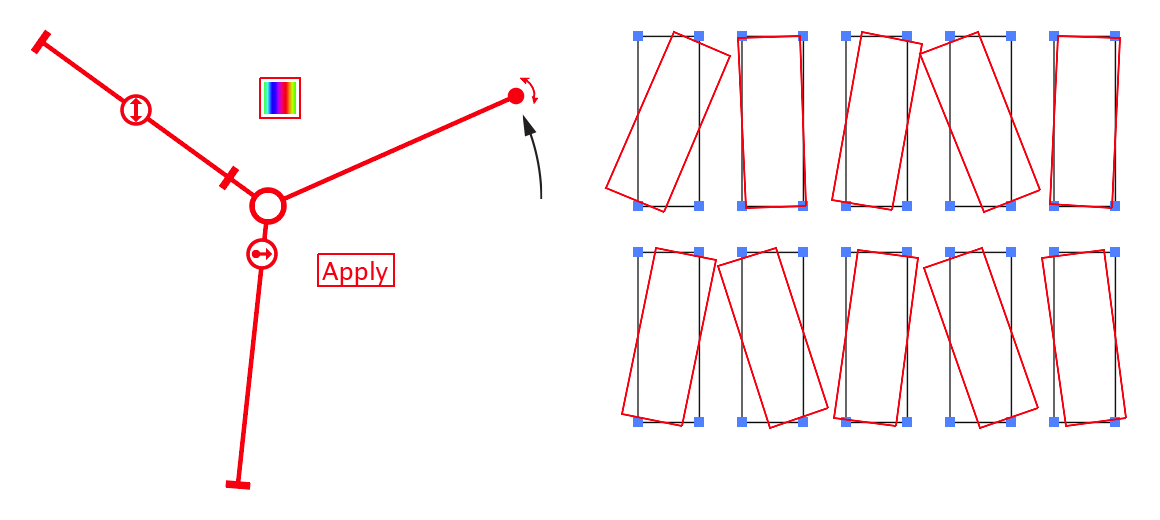
Randomino rotation arm preview
The rotation control may be double-clicked to set the rotation value numerically. Holding down the Shift key when dragging the control causes it to be constrained to steps of 10°. Holding down Command/Ctrl while dragging it enables “Slow-Drag,” which moves the control as if all cursor movements were reduced tenfold, allowing for fine-tuning.
2. Scale slider and thumb
Dragging the scale thumb changes the value up to which each piece of art will be randomly scaled from its bounding box center. For example, setting the scale value to 150% will cause the preview art to be scaled anywhere from 100% to 150%:
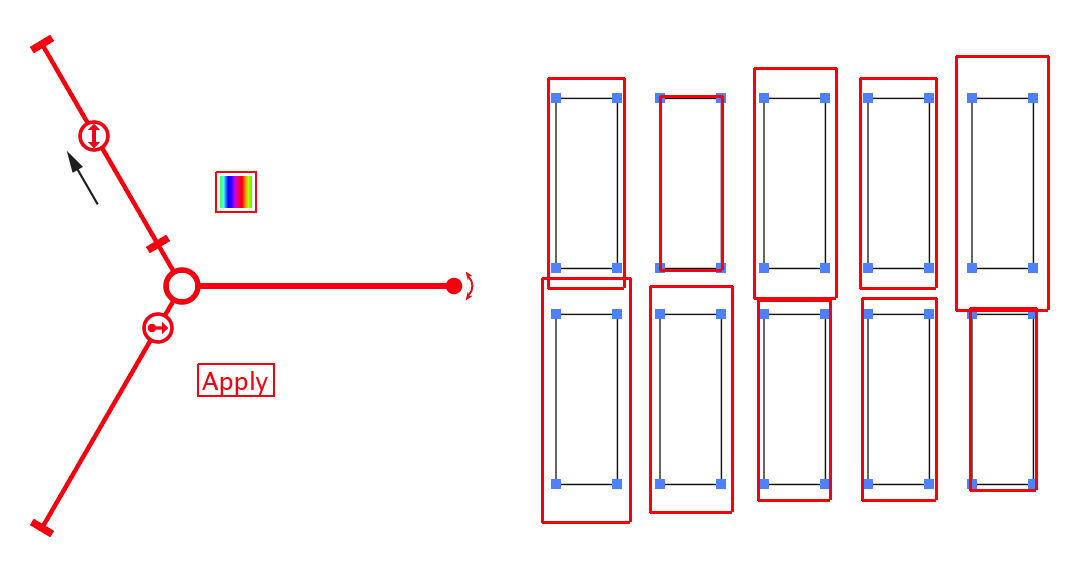
Randomini scaling control arm
The scale thumb may be double-clicked to set the scale value numerically. Holding down Shift while dragging the thumb causes the scale values to be constrained to integer values. Holding down Command/Ctrl enables “Slow-Drag”, as per the Rotation control.
3. Offset slider and thumb
Dragging the offset thumb changes the value up to which each piece of art will be randomly offset (shifted in position). For example, setting the offset value to 6pt will cause the preview art to be moved anywhere from 0 to 6 points. The offset direction is randomly chosen.
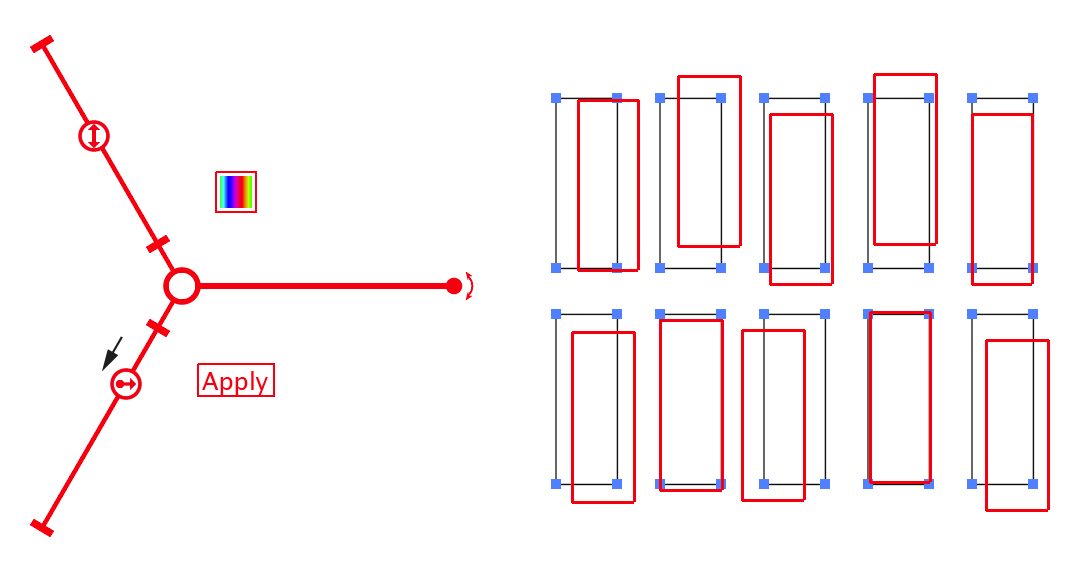
Randomini offset slider annotation
As with the scale thumb, the offset thumb may be doubleclicked to set the value numerically, Shift-dragged to constrain the value, or Command/Ctrl-dragged to enable “Slow-Drag.”
4. Apply button
Clicking the Apply button applies the currently displayed random rotation, scaling and offset to the selected art, as previewed. Immediately afterwards, since the art is still selected, new random parameters will be selected and previewed, allowing you to quickly apply multiple randomizations. To automatically deselect the art after applying the randomization, hold down Shift while clicking the Apply button. Pressing the Enter key has the same effect as clicking the Apply button unless no art is selected, in which case it opens the tool preferences dialog.
5. Hue button
Clicking the Hue button immediately randomizes the hues (strokes and fills) of the selected art. Note that black (which has zero brightness) and white (which has maximum brightness) are not affected by changing the hue. Also note that grouped objects are only affected if they have a stroke or fill applied in the Appearance panel at the group level, unless the “Ignore Grouping” preference is enabled (see Randomini: Preferences). Type objects are only affected if they have a stroke or fill applied in the Appearance panel above the Characters; to change the color of individual characters, use the Randomino panel.
6. Center control
The center control may be dragged to reposition the entire widget. Doubleclicking the center control resets all parameters to their default values (i.e., no rotation, no scaling, and no offset).
Illustrator Location:
Illustrator Main Menu > Window > Astute Graphics > Reform
A common operation is to extend one section of a path by a uniform amount. You can achieve this by placing markers of equal offset value exactly on the start and end delimiters. To save time, you may quickly create a constant offset by holding down Shift-Option (Mac) or Shift-Alt (Windows) while initially dragging the path to create a new reshape:
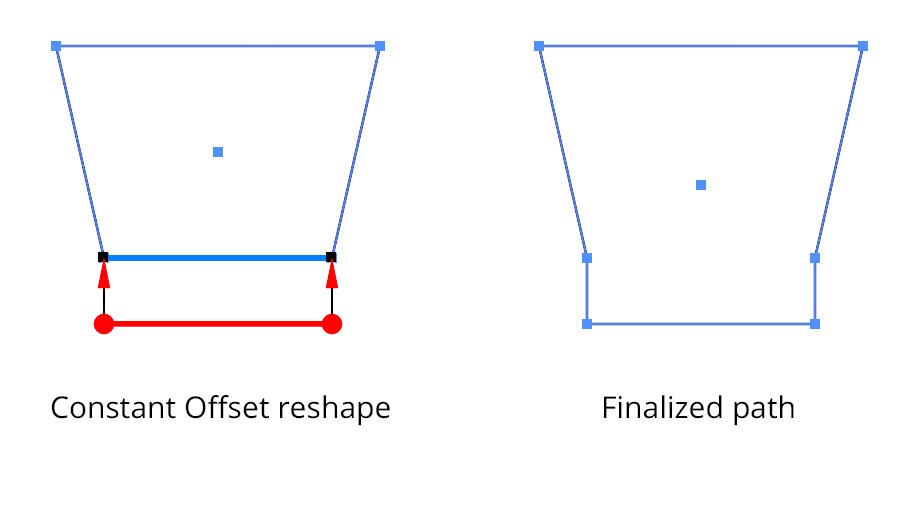
Reform Constant Offset Profiles
Illustrator Location:
Advanced Toolbar > Stylism Tool
The interactive controls for the native Offset Path live effect consist of a relocatable distance widget and a dropdown menu. For many more options when offsetting a path, including proper offsetting of open paths, as well as multiple offsets, we suggest instead using the Astute Graphics’ AG Offset live effect, which has a dedicated tool and panel.
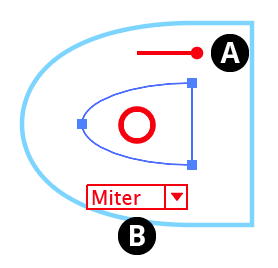
Stylism Offset Path Controls
A. Offset Distance
The length of the widget reflects the offset distance. The “ball” end can be dragged to change the offset value (to the right for positive amounts) or doubleclicked to numerically enter the value. By default, the widget is placed above the center circle. However, it can be repositioned by holding down Option/Alt and dragging the end without the ball. It will snap to the path, which can make adjusting the offset value easier because the widget will be rotated perpendicular to the path, with the offset path therefore passing directly through the ball:

Stylism Offset Path Widget Relocate
B. Corner Type
The dropdown menu specifies the types of corners used when offsetting the path, from among Miter, Round, and Bevel. The rarely-used Miter Limit parameter is not adjustable through the annotated UI.
Illustrator Location:
Illustrator Main Menu > Window > Astute Graphics > Reprofile
A common operation is to extend one section of a path by a uniform amount. You can achieve this by placing markers of equal height value exactly on the start and end delimiters. To save time, you may quickly create a constant offset by holding down Shift + Option/Alt while initially dragging the path to create a new reprofile.
Illustrator Location:
Advanced Toolbar > Stylism Stack > AG Offset
The AG Offset tool appears in Illustrator’s main toolbar (which must be in Advanced mode: View > Toolbars > Advanced), stacked under the Stylism tool. As with other stacked tools, click and hold on the top tool icon to display the tools stacked under it.

AG Offset Tool Location
The AG Offset tool’s cursor is a crosshair, except when previewing a new offset or adjusting an existing offset, in which case it appears as an arrowhead with a small group of parallel lines:

AG Offset Tool Cursors
Illustrator Location:
Advanced Toolbar > Stylism Stack > AG Offset
As the AG Offset tool has many keypresses for certain operations, we suggest installing the free Astute Graphics plugin Astute Buddy, which creates a panel that dynamically updates to inform you of the various keys which can be pressed in the tool’s current context.
The AG Offset tool is works in conjunction with the associated AG Offset panel, which generally should be open and accessible. If you are using the free Astute Graphics plugin DirectPrefs, you can have the AG Offset panel automatically be shown when the AG Offset tool is selected.
The AG Offset tool offers a graphical method for both adding and editing AG Offset live effects.
Illustrator Location:
Advanced Toolbar > Stylism Stack > AG Offset
When the tool is hovered close to or over an art object that can accept an AG Offset effect (but does not currently have one), it will automatically preview the offset as it would generally appear using the current panel parameters. The art does not need to be selected. The type of preview depends on the tool preference settings; the default preview is a full one, showing a complete trace of each offset path in the specified color (red by default, but can be changed). Previews are based on the shape of the base artwork, and will not reflect any existing live effects that might change that shape.
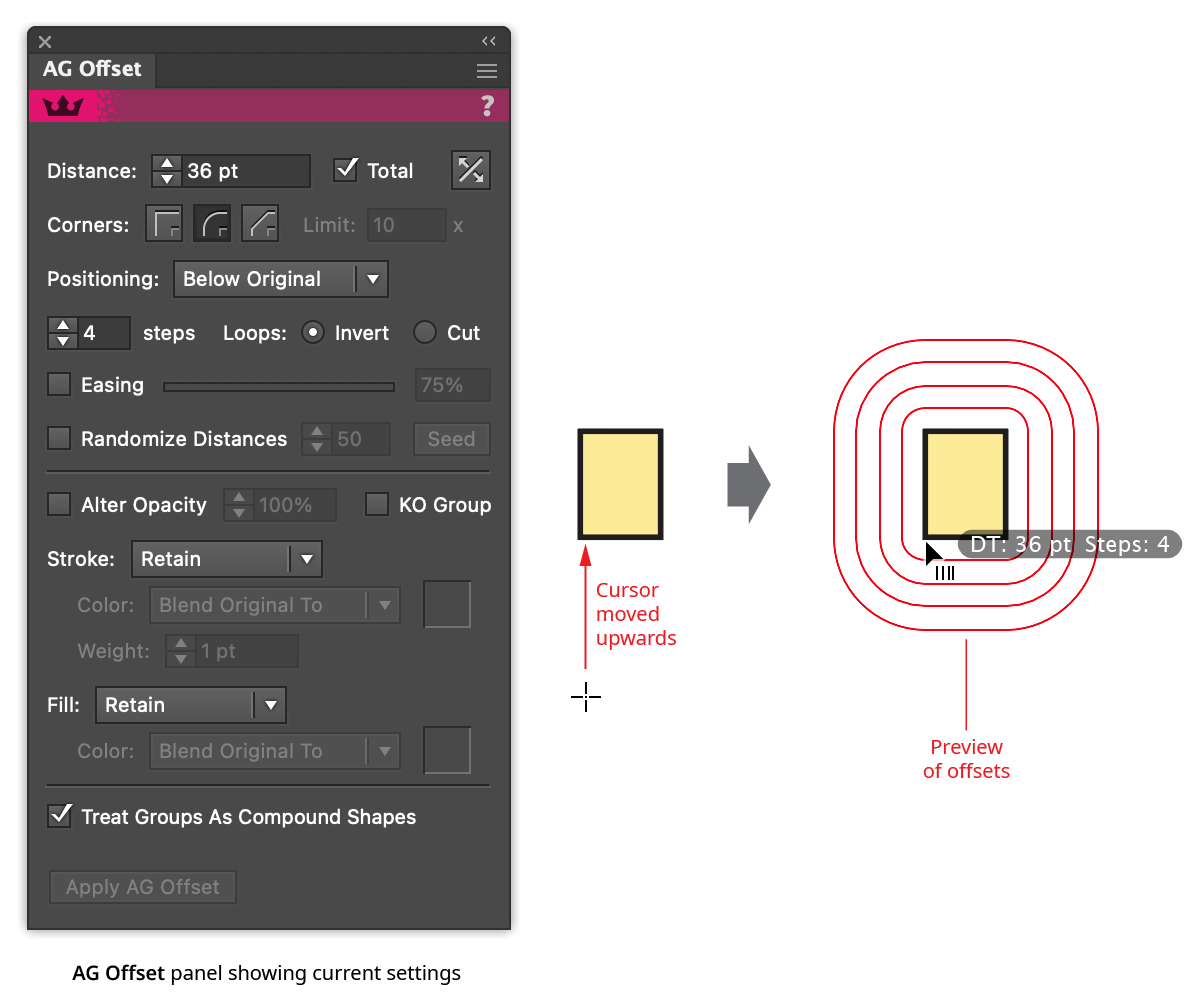
AG Offset Tool Preview
By default, annotated text by the cursor will show the offset’s distance (abbreviated as “D:”, or “DT:” if the Total parameter is enabled) and the step count. Easing, if enabled, will also be indicated. These annotations can be temporarily hidden by holding down the Option/Alt key. Clicking will add the offset effect to the art object (always placing the live effect below all strokes and fills in the object’s appearance), or the offset can be dragged first to adjust it in the same way an existing offset would be edited (see Editing Existing Offsets).

AG Offset Tool Click Apply
By default, the AG Offset tool creates previews of shadows for any artwork it is over, selected or not,
so care should be taken not to pass it inadvertently over unlocked artwork with high numbers of path segments, such as large blocks of text or objects with expanded Phantasm Halftone or Stipple effects, because calculating the offsets for these objects can take some time. In addition to keeping such art on locked layers, the preference Operate On Selected Objects Only limits the hover preview to selected objects only (see AG Offset: Preferences). If the AG Offset cursor is passed over an unlocked text object containing many characters, a warning dialog will be displayed:
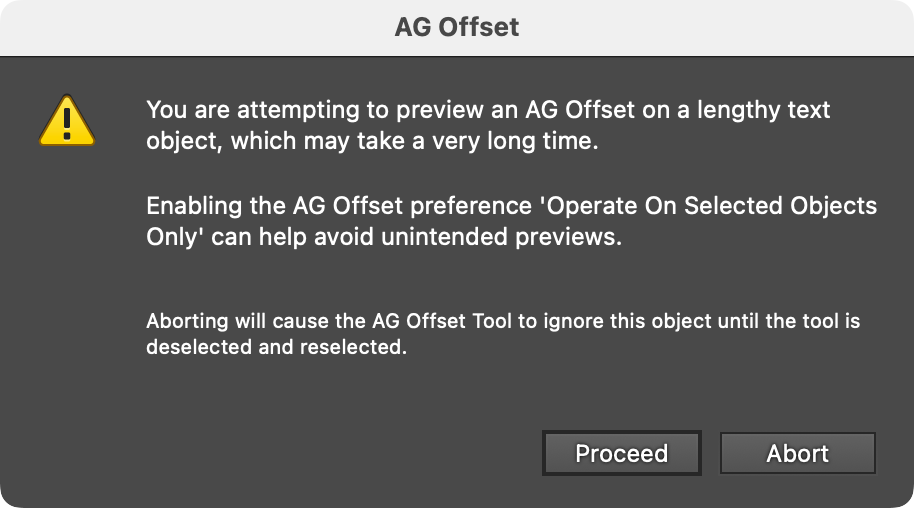
AG Offset Lengthy Text Object Warning
Click Abort unless you are sure you want to put the effect on the text object and are prepared to wait.
Illustrator Location:
Advanced Toolbar > Stylism Stack > AG Offset
When the tool is hovered close to or over an existing offset path or the original object, the existing AG Offset live effect can be edited with the tool. By default, the cursor will show the distance/steps annotations, unless these have been disabled. Dragging with the tool changes the distance parameter. When the AG Offset has multiple steps, only one of the offset paths is kept under the cursor. When the Total parameter is enabled, the last offset is kept under the cursor; otherwise the first offset is kept under the cursor.
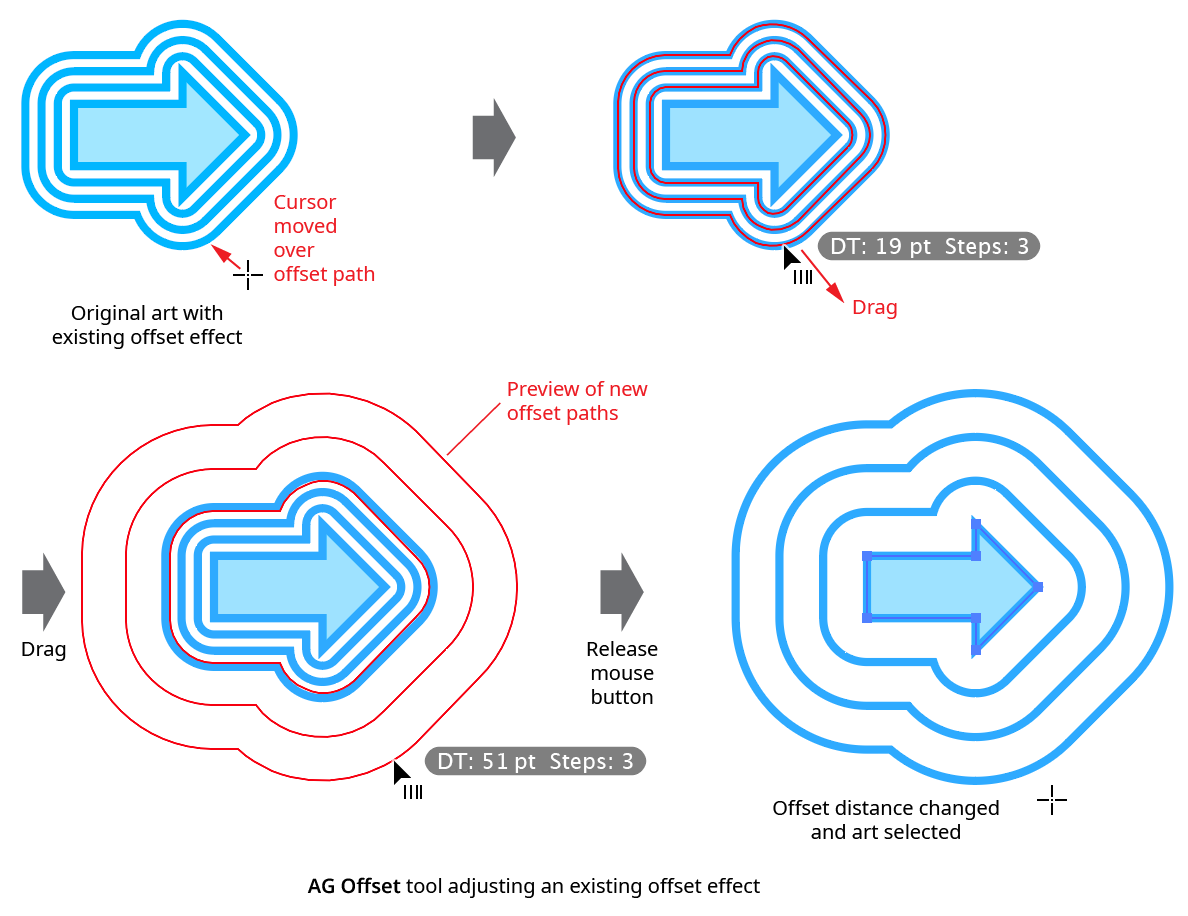
AG Offset Tool Drag Edit
While dragging to edit an AG Offset effect, a number of keypresses may be used:
Option/Alt: Constrains the distance parameter to “nice” values (integers, at 400% zoom or less).
Up Arrow/Down Arrow: Increments or decrements the Step parameter.
Left Arrow/Right Arrow: Changes the Easing parameter by 1%.
1–9: Sets the Easing parameter to 10% through 90% respectively.
A: Toggles the annotation readout on or off.
B: Toggles the Both Sides parameter on and off.
C: Changes the preview color, cycling through red, blue, magenta, green, black and grey.
D: Sets all parameters to their default values.
E: Toggles the Easing parameter on and off.
G: Toggles the Treat Groups As Compound Shapes parameter on and off.
L: Toggles the loops mode between Invert and Cut.
Q: Toggles the offset preview type between Full and Fast (see AG Offset: Preferences).
R: Available if the Step count is set to 2 or more. Toggles the Randomize Distances parameter on and off.
T: Available if the Step count is set to 2 or more. Toggles the Total parameter on and off.
U: Temporarily disables Smart Guides, if they were enabled when the drag started.
The AG Offset tool works on a single offset effect at a time, and at the highest group level. In other words, if an object is given an offset, and then grouped with another object, then normally the tool will not be able to edit the offset that is inside the group, but will instead offer to add a new offset at the group level. To edit the inner offset, either isolate the grouped object (in which case the tool can be used) or edit the offset numerically using the panel. To edit multiple offsets simultaneously, use the panel.
Illustrator Location:
Illustrator Main Menu > Window > Astute Graphics > AG Offset
The AG Offset live effect does not have a modal parameters dialog, but is instead edited using either the AG Offset tool (for many parameters) or its panel (for complete control over all its parameters). The AG Offset panel can be shown and hidden using the menu item found in the main menu at Window > Astute Graphics > AG Offset. When at least one selected object has the AG Offset live effect applied, the panel controls will update to reflect the parameters of those effects, which can then be edited. A value field which is blank or (for checkboxes) with a dash indicates that the parameter has different values in the selection. These can be unified (made the same) by entering a new value.
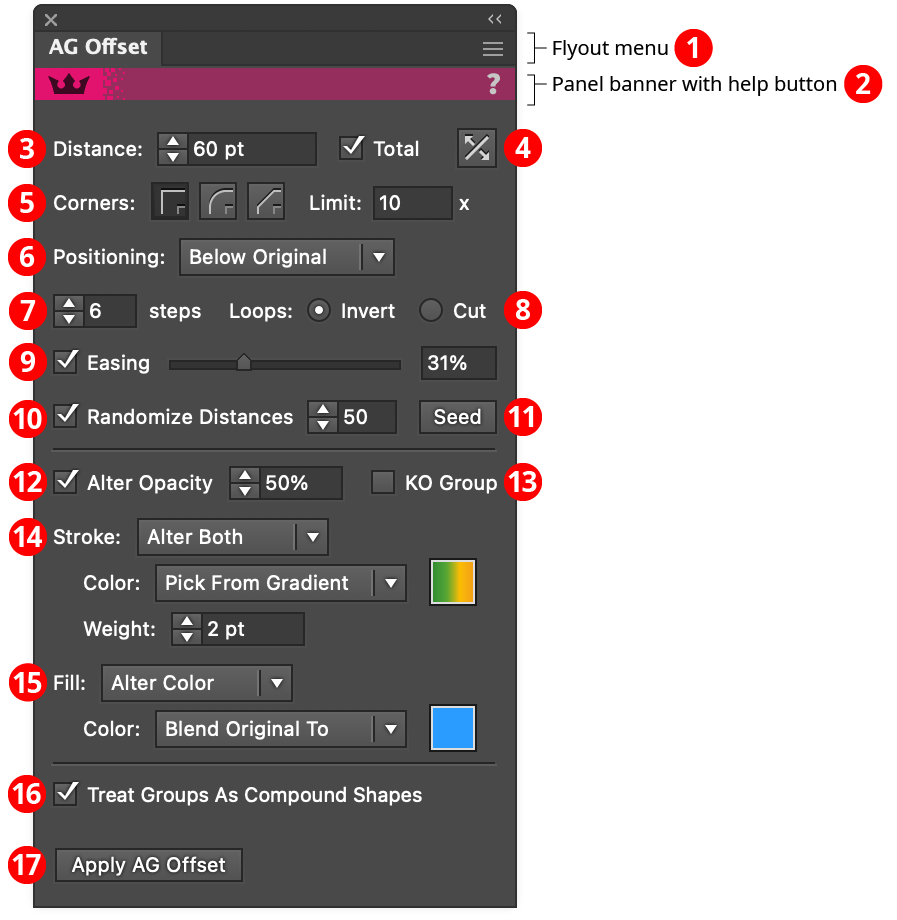
AG Offset Panel
1. Flyout menu
See AG Offset Panel: Flyout Menu.
2. Panel banner
The help button on the right opens the help documentation in the Astute Manager. If this does not automatically appear, please ensure your Astute Manager is running first.
3. Distance
Specifies the base offset distance. When more than one offset is being created (i.e., the number of Steps is set to 2 or higher), the Total checkbox controls whether the value represents the total of all offsets or the value of each offset. Easing and Randomize Distance, if enabled, will affect the final actual offset distances. Positive values represent outwards offsets (for closed paths); or offsets to the righthand side of the path (for open paths, in relation to the direction of the path).
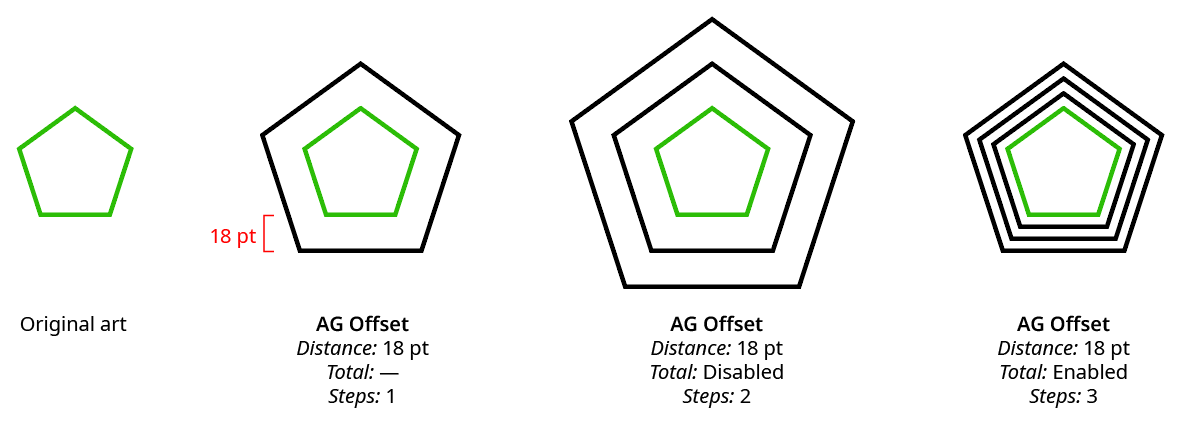
AG Offset Distance Example
4. Both Sides Button
When toggled to the enabled state (dark), the path(s) will be offset both inwards and outwards.

AG Offset Both Sides Example
5. Corner Type
The type of corner to use when offset outwards from a sharp corner on a path, from among the three standard Illustrator corner types (Mitered, Rounded, and Beveled). When set to Mitered, the Miter Limit may be specified.

AG Offset Corner Types
6. Positioning
Specifies the position of the offset paths in relation to the original path, from among Above Original, Replace Original, or Below Original.
7. Steps
The number of offsets to make, from 1 to 999 (if the Both Sides setting is enabled, the value applies to each side independently).
8. Loops
This setting is only applicable when there are loops in open paths into which the offset path cannot fit. It specifies the method used to deal with such loops. The default value is Invert, where the offset path runs on the opposite side of the loop, but can be changed to Cut, in which case the loop is “cut” from the path, essentially ignoring it.

AG Offset Loop Handling
9. Easing
When multiple steps are used, Easing causes them to become progressively larger (for values less than 50%) or progressively smaller (for values larger than 50%). In both cases, the Distance value applies to the first offset only.
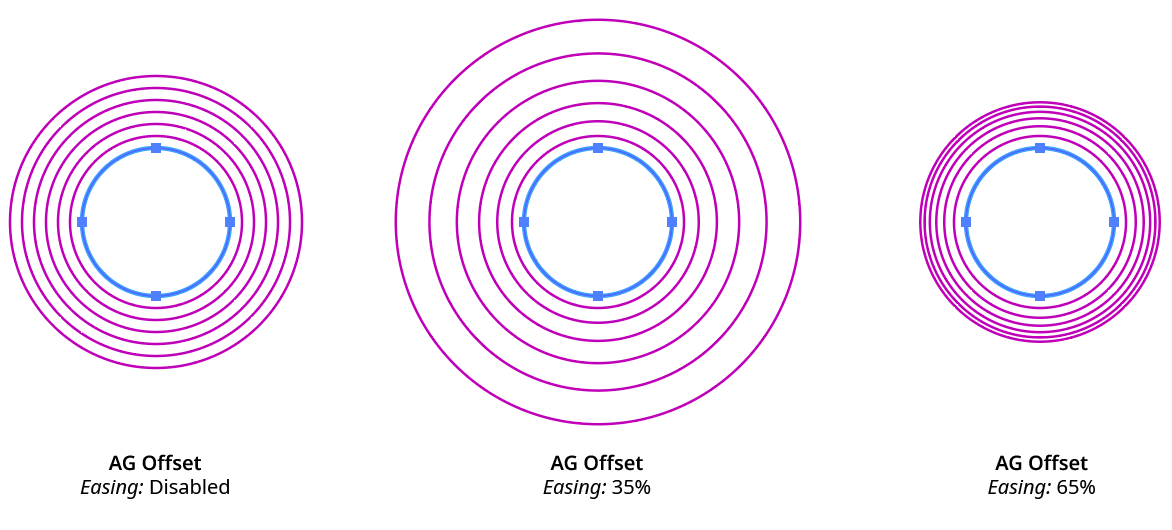
AG Offset Easing Example
10. Randomize Distances
When enabled, distances between multiple offsets are randomly changed. The specified value (from 1 to 100) controls how much variation is allowed, where 100 is maximum variation.

AG Offset Randomize Example
11. Seed
Each random seed number leads to a different sequence of random values. Clicking the button picks a new seed, thereby changing the look of the artwork. To view or specify the seed number directly, Option/Alt-click the button. This lets you recreate a previously-generated look.
12. Alter Opacity
When enabled, the opacity of the offset path is changed to the specified value. If multiple offsets are being used, their opacities are linearly blended between the opacity of the original art and the specified value. For example, if the original art had 100% opacity and the Alter Opacity value was set to 50%, and Steps was set to 4, then the offset paths would have opacities of 88%, 75%, 63%, and 50%.
13. KO [Knockout] Group
When enabled, this setting keeps multiple, partially-transparent offset paths from being transparent to each other, just as the Knockout Group setting on the native Transparency panel does.
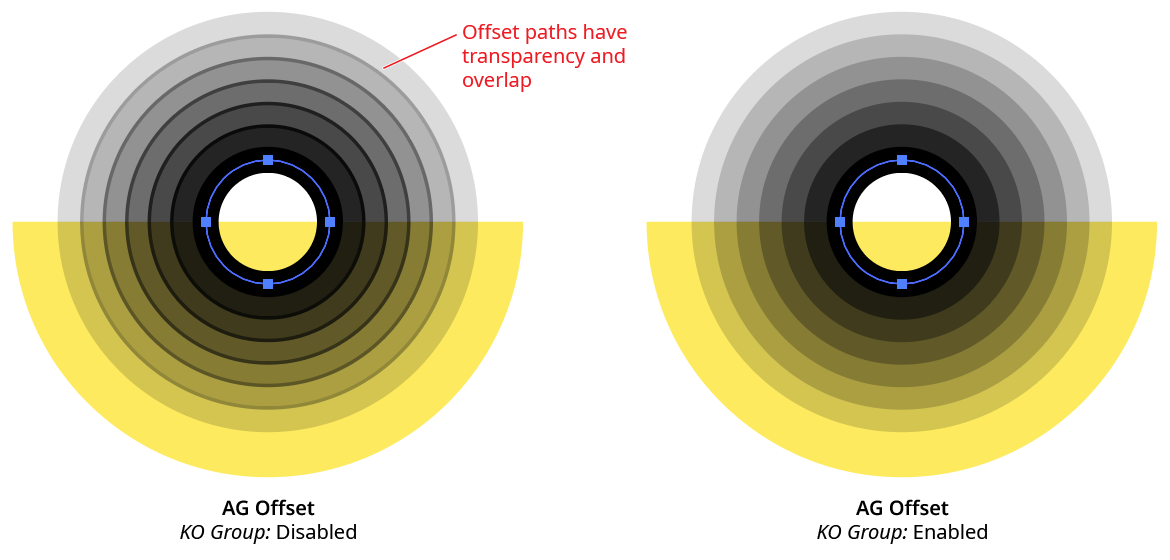
AG Offset Knockout Group Example
14. Stroke
When the AG Offset live effect is located below the fill and strokes of the artwork in the Appearance panel, this pulldown menu specifies how the stroke of the offset path should be handled:
Retain means the stroke (if any) will be simply be taken from the original path.
Remove means the offset paths will have no stroke, even if the original path had one.
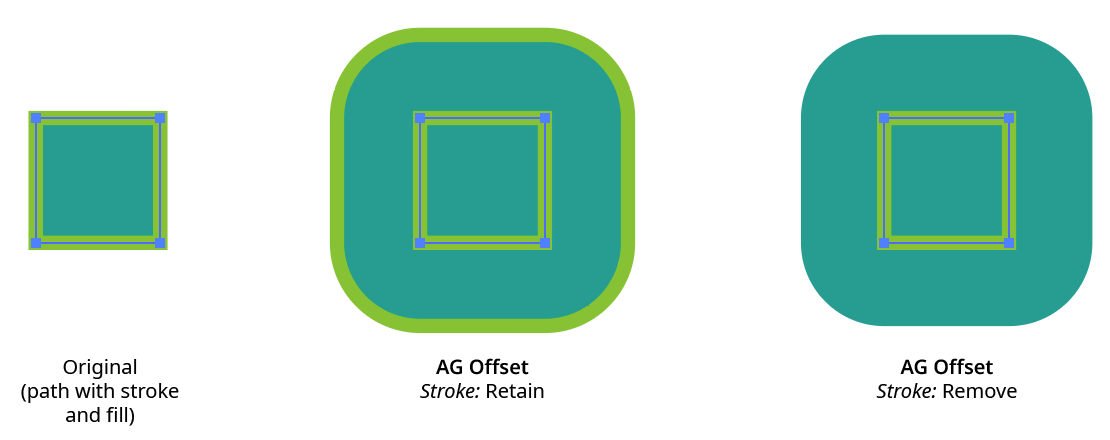
AG Offset Stroke Retain and Remove
Alter Color means the offset path (if it has a stroke), will have its stroke color changed. There are two methods for doing so, specified by the pulldown menu that will become active. When set to Blend Original To, the last offset will have its color changed to the specified color (clicking the color chip allows changing the color using the standard Color Picker); if there are multiple offset paths, the paths will take colors which blend from the original stroke color to the specified color. When set to Pick From Gradient, the stroke colors of the offset paths will be taken from the specified gradient, with the first path corresponding to the color at the start of the gradient and the last offset path corresponding to the color at the end of the gradient.
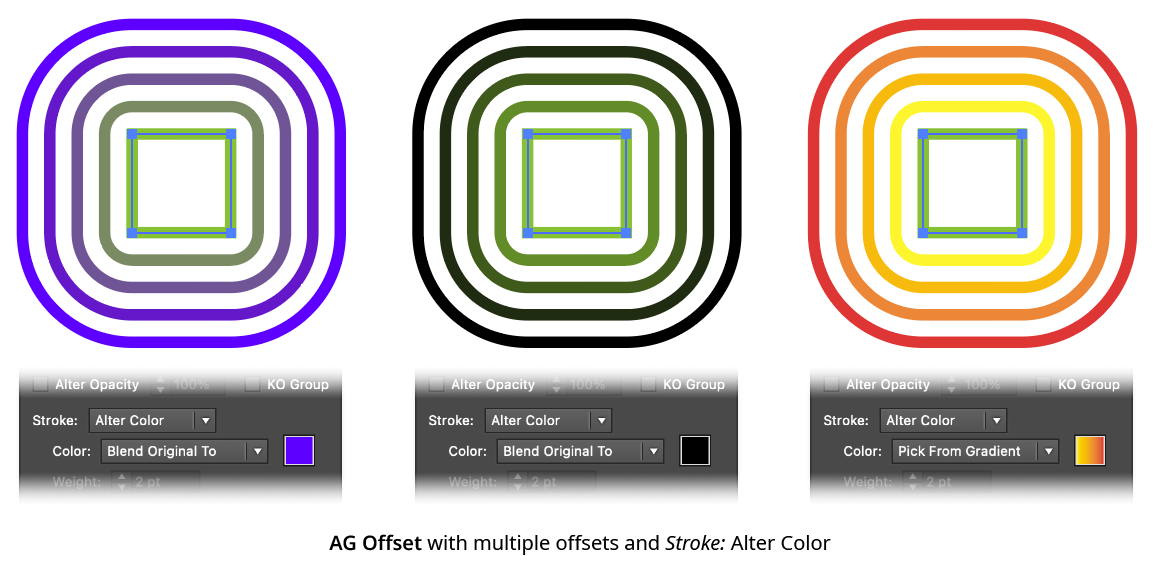
AG Offset Stroke Alter Color
Alter Weight means the offset path (if it has a stroke), will have its stroke weight changed to the specified value. If there are multiple offset paths, the paths’ strokes will be assigned weights which blend from the original stroke weight to the specified weight.
Alter Both allows changing both the color (as per Alter Color) and weight (as per Alter Weight) of the offset paths’ strokes.
Force means the color and weight of the offset path’s stroke will be set to whatever is specified, regardless of the original path’s style. This is useful for adding a stroked outline to fill-only art without having to add a stroke to the art and moving the AG Offset live effect inside the stroke with the Positioning set to Replace Original.
15. Fill
When the AG Offset live effect is located below the fill and strokes of the artwork in the Appearance panel, this pulldown menu specifies how the fill of the offset path should be handled:
Retain means the fill (if any) will be simply be taken from the original path.
Remove means the offset paths will have no fill, even if the original path had one.
Alter Color means the offset path (if it has a fill), will have its fill color changed. There are two methods for doing so, specified by the pulldown menu that will become active. When set to Blend Original To, the last offset will have its color changed to the specified color (clicking the color chip allows changing the color using the standard Color Picker); if there are multiple offset paths, the paths will take colors which blend from the original fill color to the specified color. When set to Pick From Gradient, the fill colors of the offset paths will be taken from the specified gradient, with the first path corresponding to the color at the start of the gradient and the last offset path corresponding to the color at the end of the gradient.
Force means the color of the offset path’s fill color will be set to whatever is specified, regardless of the original path’s style.
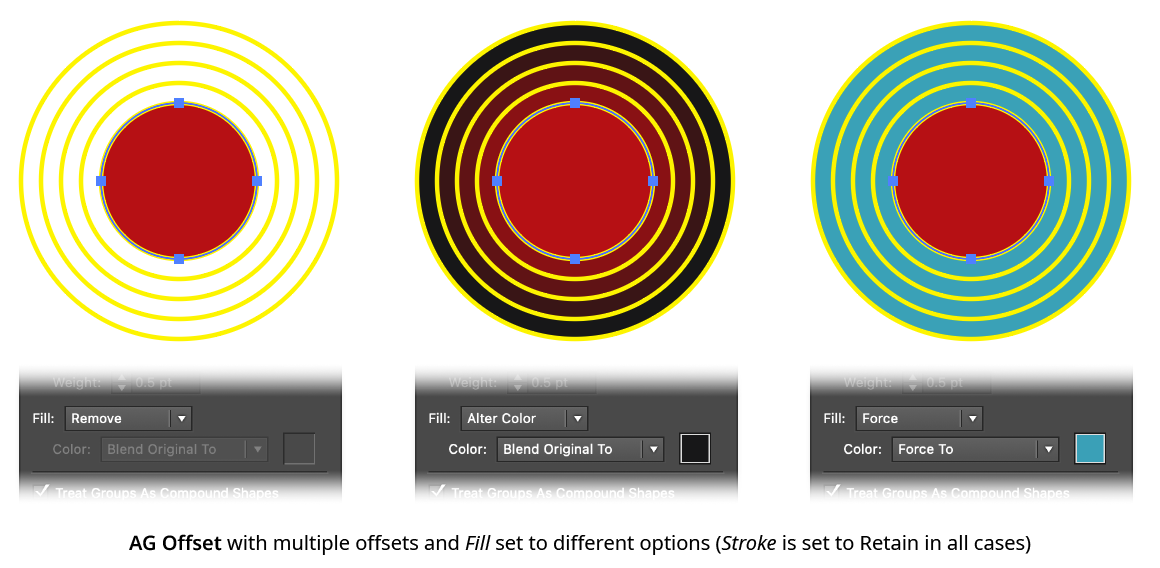
AG Offset Fill Options
16. Treat Groups As Compound Shapes
When enabled, and the effect is applied to a group (or art that is internally expanded into a group within the effect stack, such as live text), the offset paths are created as if the members of the group were united into a single compound shape:
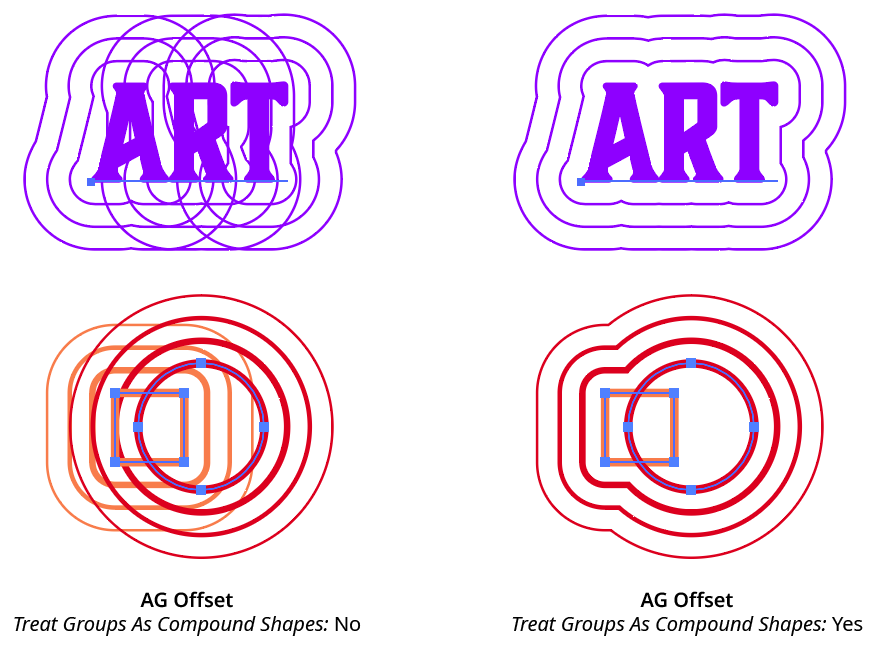
AG Offset Treat Groups as Compound Shapes
17. Apply Button
Click to apply the AG Offset live effect to the selected artwork, with the parameters set as they currently exist in the panel. If the button is not available, then either nothing is selected or the selection already contains at least one object with an AG Offset effect. If the button is clicked with Shift pressed, the offset paths will be added and immediately detached, essentially creating them as editable artwork rather than as a live effect. However, this loses the ability to preview the effect first.
Illustrator Location:
Illustrator Main Menu > Window > Astute Graphics > AG Offset > Panel Flyout Menu
The AG Offset panel flyout menu items are contextually sensitive and all items may not be available, depending on the current selection.
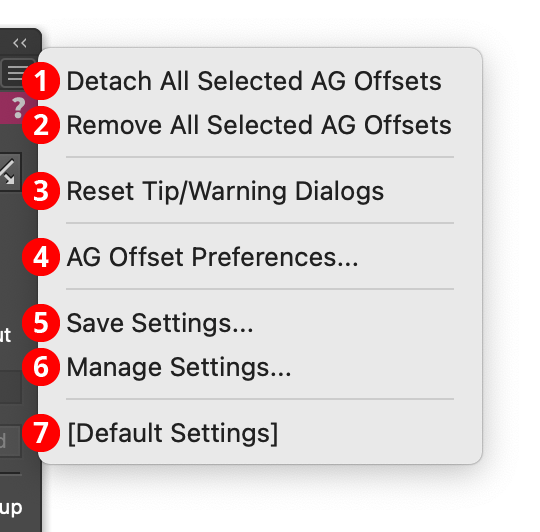
AG Offset Panel Flyout Menu
1. Detach All Selected AG Offsets
Changes the offset paths created by all AG Offset live effects in the selection into editable artwork, and removes the effect from the appearance(s). This is similar to using the native menu command Object > Expand Appearance, but is more flexible because it leaves the existing artwork (and other live effects which may be present) intact.
2. Remove All Selected AG Offsets
Removes any AG Offset live effects from the selection. (This can be done from the Appearance panel as well, but not if multiple AG Offset effects are present with different parameters. In that case, the Appearance panel will simply display “Mixed Appearances” and the ability to select the live effect and delete it will no longer be available.)
3. Reset Tip/Warning Dialogs
If one or more of AG Offset’s tip or warning dialogs (for example, the one shown when trying to use the AG Offset tool in Pattern Editing Mode) have been suppressed using the Don’t show again checkbox, clicking this button will re-enable them.
4. AG Offset Preferences...
Brings up the preference dialog (see AG Offset: Preferences).
5. Save Settings...
Captures all of the current parameter settings on the panel to a file, which can be instantly recalled later (either in the current file session or a later one). A dialog will appear through which the file name may be specified.
6. Manage Settings...
Brings up a dialog through which existing settings files may be renamed or deleted:

AG Offset Manage Settings Dialog
A. Settings List: Shows all user-saved settings. One or more settings files can be selected for use with the buttons at the bottom of the dialog by clicking on them in the list, with Shift pressed to select contiguously or Command/Ctrl pressed to select discontiguously, as normal.
B. Rename Button: If a single settings file is selected, allows it to be renamed, through a separate dialog. If the Cancel button is used, the original names will be restored.
C. Delete Button: Removes the selected settings file(s). The files are not permanently deleted until the OK button is clicked.
7. Settings Files
User-defined settings will appear below the built-in [Default Settings] menu item. Choosing a settings menu item will load the panel with the settings it had when the file was saved; the AG Offset effects in any selected art will be updated to match.
Illustrator Location:
Illustrator Main Menu > Window > Astute Graphics > AG Offset
The following operation can be recorded and played back as an Action:
1. The menu item Select > AG Offset Effects.
Illustrator Location:
Illustrator Main Menu > Select > AG Offset Effects
The Stylism plugin adds the menu item AG Offset Effects to the native Select menu. Choosing this menu item will select all unlocked art objects which contain at least one AG Offset live effect.
